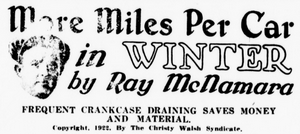|
By accessing or using The Crittenden Automotive Library™/CarsAndRacingStuff.com, you signify your agreement with the Terms of Use on our Legal Information page. Our Privacy Policy is also available there. |

More Miles Per Car in WINTER
|
|---|
|
|
More Miles Per Car in WINTER
Ray McNamara
Washington Times-Herald
December 31, 1922
FREQUENT CRANKCASE DRAINING SAVES MONEY AND MATERIAL.
Copyright, 1922, By The Christy Walsh Syndicate.
From our discussion last week on the all-important topic of lubrication it was readily seen how oiling systems differ according to the engine design.
There are other mechanical features embodied in the motors of different makes of cars, even though the oil system is identical in construction, that require one manufacturer to operate his oil system at ten pounds pressure, while another may use forty-five to sixty pounds pressure. Therefore, you can appreciate the necessity of forming an acquaintance with the particular design used in your car. Know what pressure the system is supposed to operate with, and the dangers that may result from incorrect circulation.
In breaking in a new motor, it should never be driven over twenty-four miles per hour for the first 500 miles. The oil should be drained from the crankcase and replenished with new oil after the first 200 miles, 500 miles and 1,000 miles thereafter.
A motor that has been thoroughly overhauled or one on which the pistons and connecting rods have been removed for adjustments or main bearing adjustment should be treated the same as a new motor for the first 1,000 miles of service.
This procedure is absolutely necessary because in the case of new motors there is always the danger of small metal chips or granulated particles of metal becoming detached from motor parts in the first 1,000 miles of service and circulating with the oil. This matter will scratch bearings and may cause partial or complete stoppage in one of oil lines. In the case of a repaired motor, or one that has been overhauled, there is danger of an unusual amount of lint gathering on the oil screen, which usually results from wiping parts with rags or waste. After cylinders have been bored or reground there is always danger of metal chips during the first 1,000 miles of service.
After the first 1,000 miles of service and every 5,000 miles thereafter the oil pump screen should be removed and cleaned. This is done to remove the lint, which gathers and restricts the flow. It is hard to imagine where all of this foreign matter comes from, probably most of it comes from using containers that have been wiped out with rags or waste. However, it gets in there in sufficient quantities to justify a semi-annual cleaning.
Under normal service conditions, a lot of carbon finds its way into the crankcase oil. Some of this works past the piston rings and I believe a great deal of it forms on the underside of the piston head, where temperatures run high. Dust from the road also gets into the crankcase oil through the breather or vent pipe. This is not at all surprising when you stop to think of the amount of dust that that finds its way into the works of a high-grade watch. However, dust and carbon is very harmful and causes excessive wear—I have in emergencies ground a valve to perfect seat with a pinch of dust from the road. By draining the crankcase every 1,000 miles in normal service, you insure your motor parts against this menace.


















